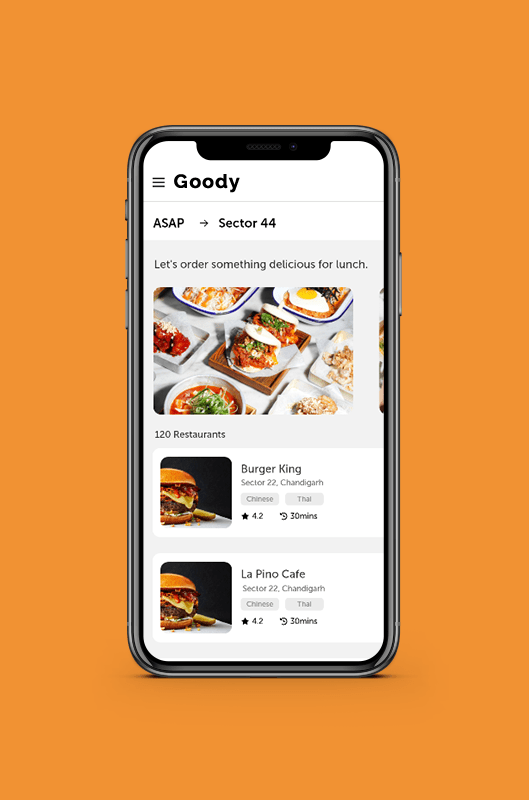Combating food waste has become an urgent global imperative as environmental consciousness reaches new heights. The alarming magnitude of wasted food necessitates innovative solutions, and that’s where Olio, a groundbreaking food sharing app, comes into play. With its disruptive approach to redistributing surplus food and curbing its detrimental impact on the planet, Olio has garnered worldwide acclaim. If you find yourself inspired by Olio’s triumphs and driven to create your own food sharing app, you have arrived at the perfect destination. This blog serves as your comprehensive guide, unveiling the step-by-step process of crafting an exceptional food sharing app like Olio.
In this blog, we will skillfully navigate the intricacies of integrating vital features, addressing design considerations, and implementing effective strategies to foster a dynamic and engaged user community. Through further reading, you will gain insight into the symbiotic relationship between technological innovation, social impact, and the pursuit of sustainable change. Discover the well-guarded secrets behind developing a remarkable food sharing app, drawing inspiration from the groundbreaking success of Olio. With this knowledge, you will be empowered to create a lasting impact in the relentless battle against food waste, propelling the industry toward remarkable growth and transformation.
What Is Olio?
Founded in 2015 by Tessa Clarke and Saasha Celestial-One, Olio is a complimentary mobile application available for both iOS and Android devices. It is a complimentary app that facilitates connections between neighbors who have surplus food or household items and those nearby who are interested in receiving them. It allows users to effortlessly share or borrow items by creating an account and listing their unwanted possessions. The platform primarily focuses on reducing food waste but also extends to non-food items.
Olio’s “Food Rescue” feature enables businesses to contribute to the cause by donating excess unsold or unserved food. These food items are subsequently listed on the app, available for individuals to collect at no cost.
Olio has garnered acclaim for its positive environmental impact. By facilitating the sharing of items that would otherwise go to waste, it has successfully reduced food waste by substantial amounts (over 2 million pounds), consequently mitigating greenhouse gas emissions. Moreover, the app has received recognition for its social benefits, fostering a sense of community and connection among its users.
In addition to its environmental and social impact, Olio also offers practical advantages. Users can save money by obtaining free items or earning a small fee for their unwanted possessions. The platform encourages resourcefulness and supports sustainable practices, contributing to a reduced carbon footprint.
How Does Olio Work For Users?
When it comes to starting with Olio, the process is incredibly straightforward. Olio operates on a trust-based system that welcomes users of all backgrounds without any financial prerequisites. All you need to do is download the app, which is completely free, and create an account. Here’s how Olio works for users:
1. Download The App
To get started, the user can simply download the free Olio app from the App Store or Google Play Store. It’s available for both iOS and Android devices.
2. Account Creation And Location Setup
Once the app is installed, the user needs to create an account by following the prompts and providing the necessary information.
During the account setup process, the user will be prompted to input their location details. This helps connect them with nearby users and businesses for convenient item sharing.
3. Listing Items
Now the user is ready to list the items they want to give away or borrow. They can add a photo, write a brief description, and specify whether they want to offer the item for free or set a price for it.
4. Visibility And Requests
Once the items are listed, they become visible to other Olio users in the vicinity. Interested users can browse through the available items and send requests to pick them up.
5. Communication And Arrangement
When someone requests an item, the user can communicate with them through Olio’s messaging system. This allows them to coordinate and arrange a suitable time and location for the item exchange.
6. Meet And Exchange
At the agreed-upon time and location, the user and the requesting party meet to complete the item exchange. It’s an opportunity for connection and sustainability as the item finds a new home.
7. Item Diversity And Radius
It’s important to note that Olio accommodates a wide range of items beyond just food. Users can list household goods, clothing, books, and more. Additionally, they can customize their pick-up radius to connect with users within a specific distance.
8. Feedback And Ratings
After each exchange, users have the option to provide feedback and rate their experience. This feedback system helps maintain a reliable and trustworthy community within the Olio network.
After successfully signing up, the Olio app swiftly connects you with fellow users in your local area, providing a convenient way to explore the array of available items within your community. What sets Olio apart is its customization feature, allowing you to tailor your search by specifying a pick-up radius that suits your preferences, ranging from 0.6 miles to 16 miles. This ensures that the items you find are easily accessible and located within a comfortable distance for pick-up.
Olio caters to two main categories of items: food and non-food. Emphasizing quality and safety, Olio maintains a high standard for food listings. Every food item shared on the app must meet the criteria of being “good enough for you to eat,” ensuring that the food being shared is in excellent condition and suitable for others. Beyond food, Olio also welcomes the sharing of non-food items, making it a comprehensive platform for giving unused belongings a new purpose.
What truly distinguishes Olio is its collaboration with local businesses. In select areas, supermarkets and food establishments participate by listing unsold food items at the end of the day. Olio has “Food Waste Heroes”, and they play a crucial role in collecting and distributing surplus food. Anyone can join as Food Waste Heroes and volunteer to actively promote Olio and encourage local businesses to donate their unsold food.
How Does an App like Olio Work In The Backend?
Here is the technical overview of how Olio works in the backend:
1. Server Architecture
Olio employs a server-client architecture, where the server handles the core functionalities and processes the data exchanged between users.
2. APIs And Microservices
Olio utilizes APIs (Application Programming Interfaces) to enable communication between the client-side app and the server-side backend. The backend is designed as a collection of microservices, each responsible for specific functionalities, such as user management, item listing, messaging, and notifications.
3. User Management
The backend includes a user management system that handles user registration, authentication, and account information storage. It ensures secure access to user-specific data and functionalities.
4. Listing And Item Management
Olio’s backend facilitates the listing and management of items. When a user creates a new listing, the backend stores the item details, such as title, description, photo, and pricing information, in a database. The backend also handles the retrieval of item listings based on various criteria, such as location and category.
5. Location-based Services
Olio leverages location-based services to connect users with nearby items and users. The backend incorporates geolocation APIs to determine the proximity between users and facilitate localized item discovery.
6. Messaging System
The backend implements a messaging system that enables users to communicate with each other within the app. It manages the exchange of messages between users, ensuring reliable and real-time communication.
7. Notifications
Olio’s backend integrates notification services to send push notifications or emails to users for various events, such as new item requests, message updates, or important app updates. This helps keep users informed and engaged with the platform.
8. Data Storage And Database
Olio’s backend utilizes a robust database system to store user data, item listings, messaging records, and other relevant information. The database ensures data integrity, scalability, and efficient retrieval.
9. Scalability And Performance
To handle a growing user base and increasing demands, Olio’s backend is designed to be scalable. It employs techniques such as load balancing, caching, and horizontal scaling to ensure optimal performance and responsiveness.
10. Security And Privacy
Security measures, such as data encryption, secure APIs, and user authentication, are implemented to safeguard user information and ensure privacy.
11. Analytics And Monitoring
Olio’s backend incorporates analytics and monitoring tools to gather insights on user behavior, system performance, and usage patterns. This data aids in optimizing the platform, identifying areas for improvement, and enhancing the user experience.
Note: The specific implementation details may vary depending on Olio’s actual backend architecture and technologies used.
Why Businesses Must Invest In A Food Sharing App Development Like Olio?
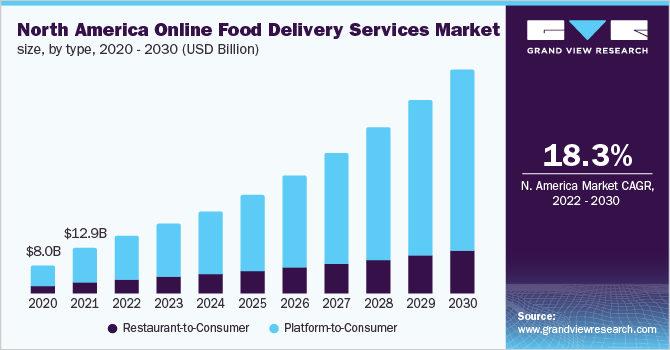
The market size of the online food delivery services industry worldwide reached a significant valuation of USD 50.70 billion in 2021. Moving forward, it is anticipated to exhibit a remarkable compound annual growth rate (CAGR) of 18.7% from 2022 to 2030.
This remarkable expansion in the global online food delivery services market reflects the increasing demand for convenient and efficient food delivery options. As consumers continue to embrace the ease and accessibility offered by online platforms, the market has experienced a surge in popularity and adoption.
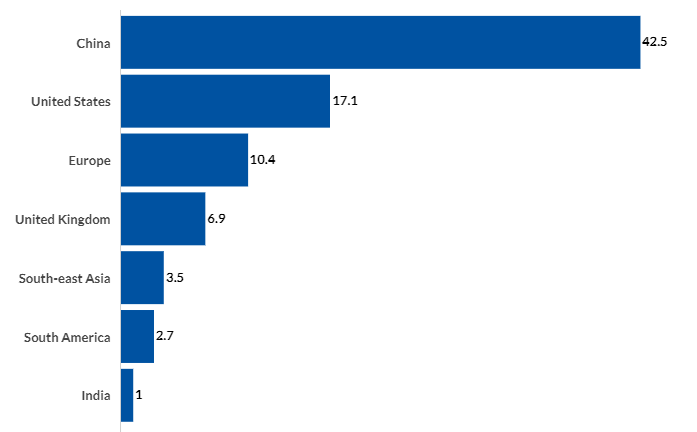
Sources: Company Data, Bloomberg, Daxue Consulting, The Information
According to a report by Business of Apps, In 2022, China had the largest food delivery market, with a market size of $42.5 billion. On a global scale, the market size of the food delivery app industry is projected to reach $165 billion by 2029.
Furthermore, there are a number of other reasons why Businesses should invest in food sharing apps like Olio:
- They can help to reduce food waste
- Improve their corporate social responsibility (CSR) image,
- Improve their brand reputation
- Build relationships with local communities
- Promote their sustainability efforts
- Save money, and reach new customers.
According to the Food and Agriculture Organization of the United Nations, one-third of all food produced for human consumption is wasted. This wasted food represents a significant amount of resources that could be used for other purposes.
Here are some businesses that have benefited from investing in food sharing apps:
- Pret A Manger, a UK-based coffee chain, has partnered with Olio to donate its unsold food to the app. This has helped Pret to reduce food waste and improve its CSR image.
- Costa Coffee, another UK-based coffee chain, has also partnered with Olio to donate its unsold food. Costa has found that the partnership has helped to increase customer loyalty and improve its brand reputation.
- Sodexo, a global food services company, has used Olio to donate food to schools and other organizations. Sodexo has found that the partnership has helped to reduce food waste and improve the health and well-being of its employees.
Must-have Features Of A Food Sharing App Like Olio
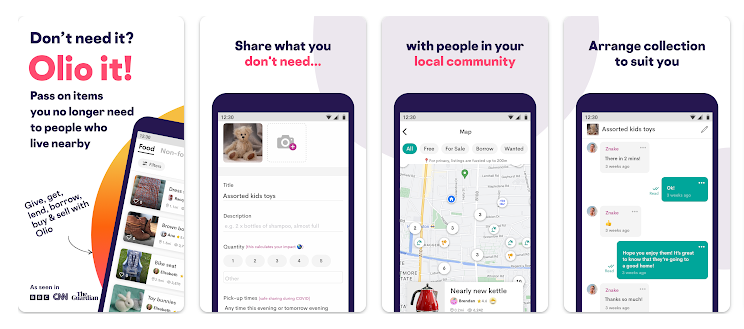
Here are the basic features for User, Seller, and Admin Panel that you can have in your Olio like food sharing app:
A. User Panel
- User Registration and Login: Allows users to create an account, log in, and manage their profile.
- Search and Browse Listings: Enables users to search for available food listings, filter results, and view details of each item.
- Request/Reservation: Allows users to request or reserve food items from sellers, specifying quantity, pick-up/delivery preferences, and timing.
- Messaging System: Enables users to communicate with sellers/admin regarding their requests, arrange pick-up details, or ask questions.
- Rating and Review: Allows users to rate and provide feedback on their experience with sellers and their food items.
- Notifications: Keeps users informed about important updates, such as new listings, status changes, or responses from sellers.
- Favorites and Saved Searches: Provides options for users to save their favorite listings and set up saved searches for specific food items or locations.
- Account Settings: Allows users to manage their account details, update personal information, and modify notification preferences.
- Social Sharing: Integration with social media platforms to enable users to share their experiences, listings, or success stories with their networks.
- In-App Messaging: A real-time chat feature that allows users to communicate directly with other users for community building or collaborative initiatives.
- Community Forums or Groups: A dedicated space for users to engage in discussions, share tips, recipes, or collaborate on initiatives related to reducing food waste.
- Push Notifications: Instant alerts and reminders for important updates, new listings, or time-sensitive offers.
B. Seller Panel
- Seller Registration and Login: Allows sellers to create an account, log in, and manage their profile.
- Listing Management: Enables sellers to create, edit, and delete food listings, including details such as item description, quantity, price (if applicable), and availability.
- Order Management: Provides tools to manage incoming requests, including accepting, rejecting, or communicating with users regarding orders.
- Messaging System: Enables sellers to communicate with users/admin regarding their listings, order inquiries, or pick-up/delivery arrangements.
- Sales Analytics: Provides insights and reports on sales performance, order history, and revenue generated.
- Notifications: Notifies sellers about new order requests, messages from users, or important updates related to their listings.
- Account Settings: Allows sellers to manage their account information, update contact details, and modify notification preferences.
- Inventory Management: Tools for sellers to track and manage their food inventory, set alerts for low stock levels, and update availability status.
- Promotions and Discounts: Features for sellers to create promotional campaigns, offer discounts, or highlight special offers to attract users.
- Sales and Revenue Tracking: Comprehensive reporting on sales performance, revenue earned, and financial transactions with breakdowns by date, item, or category.
- Order Fulfillment and Tracking: Integration with delivery services or order tracking systems to provide real-time updates to users on the status of their orders.
C. Admin Panel
- Dashboard: Provides an overview of key metrics, system status, and important notifications.
- User Management: Allows the admin to manage user accounts, including registration, authentication, and account details.
- Seller Management: Enables the admin to manage seller accounts, including verification, approval, and monitoring.
- Listings Management: Allows the admin to view, edit, and delete listings created by users and sellers.
- Analytics and Reports: Provides insights and reports on user activity, food listings, usage statistics, and other relevant data.
- Communication Tools: Enables the admin to communicate with users, sellers, and other stakeholders via messaging or notifications.
- Payment Management: Facilitates the management of financial transactions, including refunds, payments to sellers, and fee calculations.
- System Configuration: Allows the admin to configure system settings, such as app preferences, notifications, and security parameters.
- Content Management: Provides tools for managing static content, FAQs, terms of service, and privacy policies.
- Customer Support: Includes features for handling user inquiries, support tickets, and resolving disputes.
- Moderation Tools: Provides the ability to moderate listings, user-generated content, and user behavior to ensure compliance with platform guidelines and policies.
- Reporting System: Enables users and sellers to report issues, violations, or inappropriate content, with a feature for the admin to review and take necessary actions.
- Integration with Third-Party Services: Integration with external services like payment gateways, email providers, or analytics platforms for enhanced functionality and data analysis.
- Advanced Analytics: Advanced reporting and data visualization tools for in-depth analysis of user behavior, trends, and performance indicators.
- System Logs and Audit Trails: Tracks and records important system events and user activities for security, troubleshooting, and compliance purposes.
- Multi-language and Localization Support: Allows the admin to configure the platform to support multiple languages and cater to users from different regions.
Additionally, you can include a few additional advanced features you can consider to make your Olio-like food sharing app stand out:
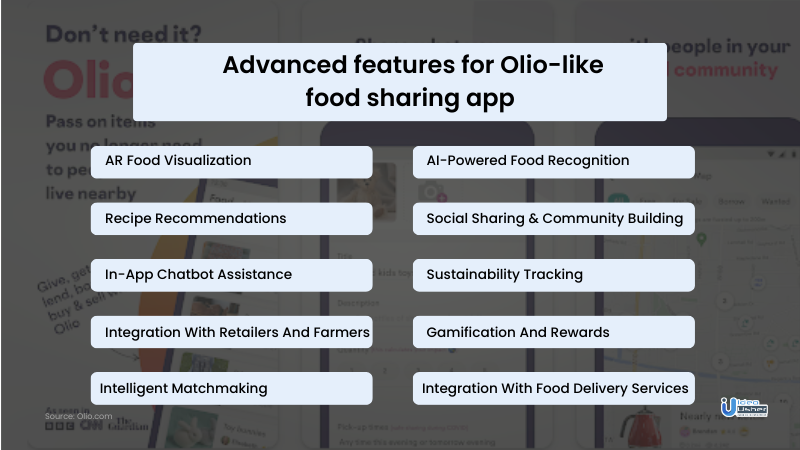
1. Augmented Reality (AR) Food Visualization
Implement AR technology to allow users to visualize how a food item will look in their own space, helping them make informed decisions when choosing surplus food items.
2. AI-Powered Food Recognition
Utilize AI algorithms to analyze photos of surplus food items uploaded by users and automatically generate accurate descriptions, making it easier for users to list their items.
3. Recipe Recommendations
Offer personalized recipe suggestions based on the surplus food items available, inspiring users to create delicious meals and reduce waste.
4. Social Sharing And Community Building
Enable users to share their food sharing experiences, success stories, and recipes on social media platforms, fostering a sense of community and encouraging engagement.
5. In-App Chatbot Assistance
Incorporate a chatbot feature that can provide instant assistance to users, answering common questions, guiding them through the app’s features, and providing support.
6. Sustainability Tracking
Allow users to track and visualize their personal impact on reducing food waste, such as the amount of food saved, reduced CO2 emissions, or meals shared with others.
7. Integration With Local Retailers And Farmers
Collaborate with local grocery stores, farmers, or restaurants to enable them to list surplus food directly on the app, expanding the availability of food items for sharing.
8. Gamification And Rewards
Introduce gamification elements such as badges, challenges, or reward systems to incentivize users to actively participate in reducing food waste and engage with the app.
9. Intelligent Matchmaking
Utilize machine learning algorithms to match surplus food items with users who are most likely to be interested in them based on their preferences, location, and previous interactions.
10. Integration With Food Delivery Services
Partner with food delivery platforms to offer seamless delivery options for users who prefer to have surplus food items delivered to their doorstep.
These features leverage advanced technologies, promote user engagement, and align with current trends in the food sharing and sustainability space. By incorporating these features, you can enhance the user experience, increase app usage, and drive greater impact in reducing food waste.
How To Develop A Food Sharing App Like Olio?
Here are the fundamental steps involved in the development of a food sharing app like Olio:
1. Project Planning And Analysis
- Define the app’s goals, target audience, and features.
- Conduct market research and competitor analysis.
- Create user personas and user stories.
- Define the technical requirements and constraints.
2. Technology Stack Selection
- Choose a suitable tech stack based on the project requirements and team expertise.
- Consider using frameworks such as:
- Frontend: React Native, Flutter, or native app development (Swift for iOS, Kotlin for Android).
- Backend: Node.js, Ruby on Rails, Django, or Laravel.
3. Database Design And Architecture
- Design the database schema to store user data, food listings, orders, and other relevant information.
- Select a suitable database system like MySQL, PostgreSQL, or MongoDB.
4. User Interface Design
- Create wireframes and mockups to define the app’s layout and visual design.
- Use design tools like Sketch, Figma, or Adobe XD for UI/UX design.
5. Frontend Development
- Develop the user interface using the chosen frontend framework.
- Implement responsive design to ensure compatibility across various devices.
- Utilize HTML, CSS, and JavaScript to build interactive and visually appealing interfaces.
- Leverage libraries and frameworks like React, Angular, or Vue.js.
6. Backend Development
- Implement the server-side logic and APIs to handle user authentication, food listing management, and order processing.
- Develop RESTful or GraphQL APIs using frameworks like Express.js or Django REST Framework.
- Implement user authentication and authorization using technologies like JWT or OAuth.
7. Integration of Third-Party Services
- Integrate services like geolocation (Google Maps API), payment gateways (Stripe, PayPal), and cloud storage (AWS S3) for efficient functionality.
- Utilize APIs provided by these services and follow their documentation for seamless integration.
8. Implement Features and Functionality
- Develop features like food listing creation, search and filtering, chat/messaging functionality, and notifications.
- Implement algorithms for intelligent matching, recommendation systems, and pricing suggestions.
- Integrate features like barcode scanning, allergen detection, or augmented reality (if applicable).
9. Testing And Quality Assurance
- Conduct unit, integration, and end-to-end testing to ensure the app’s functionality and performance.
- Perform usability testing and gather feedback from real users to identify and address any issues or improvements.
10. Deployment And Maintenance
- Deploy the app to the chosen app stores (Apple App Store, Google Play Store) or distribute it via other distribution platforms.
- Continuously monitor and maintain the app, addressing bug fixes, security updates, and feature enhancements based on user feedback.
Throughout the development process, you must follow best practices for code quality, security, and scalability. You can collaborate with a team of designers, developers, and testers to ensure smooth execution and deliver a high-quality food-sharing app like Olio.
Technology Stack
| Payment Processing | Stripe |
| Display & Programmatic Advertising | Google Ads, LinkedIn Ads, Facebook Ads, and Moat |
| Popup & Form Builders | Poptin |
| Web & Mobile Analytics | Google Analytics and Moat |
| Project Management | jQuery |
| Product Analytics | Heap Inc |
| Social Media Management | Google Ads, Facebook Ads, LinkedIn Ads, Google Tag Manager, YouTube |
| Other technologies | Google, HelpScout, Cloudflare, and WordPress |
How Will The Listing Process Work On An App Like Olio?
To list an item on an app like Olio, you can simply take a picture, write a brief description, and upload it to the site. The item will then be immediately visible on the listings page.
There will be a provision of the “Request this” button that you can click on if you are interested in an item. This way, you can send a message to the person who listed it. The person who listed the item may have set a specific time for pick-up. So, if they accept your request, you might need to arrange a meeting time and place with them.
It is important to note that with the Olio business model, food and household items will always be available on the app, but you may only sometimes be able to get the item you want, as popular items may receive multiple requests.
Top Players In The Food Sharing Industry
Here are the 5 best players in the food-sharing market:
1. Too Good To Go
- Launched in 2016, it offers surplus, unsold food from supermarkets, cafes, and restaurants at heavily discounted prices.
- Users can browse participating venues by name, location, and time of day.
- Food is presented in a surprise “magic bag” at one-third of the retail price.
- Available in 17 countries with 46 million users.
- Available on Apple and Android.
2. Karma
- Rescues fresh food that would otherwise be wasted from restaurants, cafes, and wholesalers.
- Offers food at up to 50% off, with transparent visibility of available meals.
- Has saved over 4 million meals and 1,800 tonnes of CO2.
- Predominantly used in Sweden and France, with a recent launch in the UK (currently available only in London).
- Available on Apple and Android.
3. Olio
- Established in 2015, it claims to be the world’s largest food-sharing network.
- Connects neighbors and volunteers with local businesses to redistribute surplus food.
- Users can upload pictures of their items, and neighbors receive customized alerts to request and arrange pick-up.
- Experienced a significant increase in listings during the lockdown, emphasizing community interaction.
- Available on Apple and Android.
4. Kitche
- Helps users manage food waste at home by tracking purchases and planning meals accordingly.
- Allows users to scan or upload receipts to create an inventory of available food.
- Generates meal plans based on available items, considering use-by dates.
- Supports reducing food waste by optimizing meal planning.
- Available on Apple and Android.
5. NoWaste
- Offers a hi-tech inventory system for users to track food in their fridge, freezer, and pantry.
- Scanning shopping receipts helps set use-by dates, receive notifications, and record shopping lists and meal plans.
- Provides insights on the most wasted food types and allows sharing of stats with others for motivation.
- Helps users reduce food waste by managing inventory effectively.
- Available on Apple and Google.
Conclusion
The development of a food sharing app like Olio offers tremendous potential to address the global issue of food waste. The development process requires careful planning and execution to ensure its effectiveness and user-friendliness. By incorporating essential and advanced features such as real-time updates, AI-ML, AR, geolocation, etc., you can create a platform that enables individuals and businesses to share surplus food effortlessly.
To transform your vision into a reality, choosing the right app development company is paramount. Among the options available, Idea Usher stands out as a leading app development company with a proven track record. Our team of experienced developers, designers, and project managers are dedicated to delivering high-quality applications that meet client specifications. Our extensive expertise in building similar applications and our understanding of the food sharing sector makes us an ideal partner for developing your food sharing app.
We can create an app that revolutionizes food sharing, promotes sustainability, and positively impacts communities worldwide. With our expertise and your vision, you can make a meaningful difference in reducing food waste and creating a more sustainable future.
Work with Ex-MAANG developers to build next-gen apps schedule your consultation now
Contact Idea Usher at [email protected]
Or reach out at: (+1)732 962 4560, (+91)859 140 7140
FAQ
Q: What are the essential features to include in a food sharing app?
A: When developing a food-sharing app like Olio, there are several key features to consider. These include user profiles for easy registration and authentication, real-time updates to showcase available food listings, geolocation to connect users in the same area, messaging functionality to facilitate communication between users and a rating/review system for trust and accountability.
Q: How can I ensure the safety and quality of shared food in the app?
A: Safety and quality are paramount in a food sharing app. Implementing a verification process for users and their food donations can help ensure that only safe and consumable items are shared. Encourage users to provide accurate descriptions, expiration dates, and photos of the food items. Additionally, consider incorporating user ratings and reviews to help maintain a reliable and trustworthy community.
Q: How can I promote user engagement and community building in the app?
A: To encourage user engagement, it is important to foster a sense of community within the app. Incorporate social features like user profiles, messaging capabilities, and the ability to follow or connect with other users. Consider implementing a feedback system where users can share their experiences and suggest improvements. Organizing local events or initiatives related to food sharing can also help build a strong and active user community.
Q: How can I monetize a food sharing app?
A: Monetizing a food sharing app can be achieved through various strategies. One approach is to offer premium features or a subscription model that provides additional benefits to users, such as enhanced visibility for their listings or exclusive access to certain food sources. You can also collaborate with local businesses or organizations to display targeted advertisements or sponsorships within the app. Additionally, exploring partnerships with food delivery services or grocery stores can create revenue streams through commissions or referral programs. Remember, while monetization is important, it is crucial to strike a balance that aligns with the core purpose of reducing food waste and maintaining a positive user experience.





















